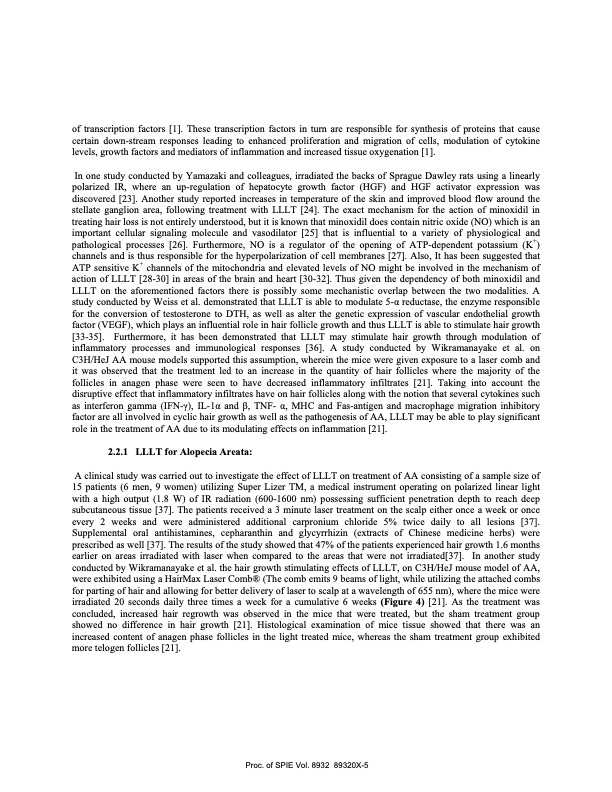
PDF Publication Title:
Text from PDF Page: 006
of transcription factors [1]. These transcription factors in turn are responsible for synthesis of proteins that cause certain down-stream responses leading to enhanced proliferation and migration of cells, modulation of cytokine levels, growth factors and mediators of inflammation and increased tissue oxygenation [1]. In one study conducted by Yamazaki and colleagues, irradiated the backs of Sprague Dawley rats using a linearly polarized IR, where an up-regulation of hepatocyte growth factor (HGF) and HGF activator expression was discovered [23]. Another study reported increases in temperature of the skin and improved blood flow around the stellate ganglion area, following treatment with LLLT [24]. The exact mechanism for the action of minoxidil in treating hair loss is not entirely understood, but it is known that minoxidil does contain nitric oxide (NO) which is an important cellular signaling molecule and vasodilator [25] that is influential to a variety of physiological and pathological processes [26]. Furthermore, NO is a regulator of the opening of ATP-dependent potassium (K+) channels and is thus responsible for the hyperpolarization of cell membranes [27]. Also, It has been suggested that ATP sensitive K+ channels of the mitochondria and elevated levels of NO might be involved in the mechanism of action of LLLT [28-30] in areas of the brain and heart [30-32]. Thus given the dependency of both minoxidil and LLLT on the aforementioned factors there is possibly some mechanistic overlap between the two modalities. A study conducted by Weiss et al. demonstrated that LLLT is able to modulate 5-α reductase, the enzyme responsible for the conversion of testosterone to DTH, as well as alter the genetic expression of vascular endothelial growth factor (VEGF), which plays an influential role in hair follicle growth and thus LLLT is able to stimulate hair growth [33-35]. Furthermore, it has been demonstrated that LLLT may stimulate hair growth through modulation of inflammatory processes and immunological responses [36]. A study conducted by Wikramanayake et al. on C3H/HeJ AA mouse models supported this assumption, wherein the mice were given exposure to a laser comb and it was observed that the treatment led to an increase in the quantity of hair follicles where the majority of the follicles in anagen phase were seen to have decreased inflammatory infiltrates [21]. Taking into account the disruptive effect that inflammatory infiltrates have on hair follicles along with the notion that several cytokines such as interferon gamma (IFN-γ), IL-1α and β, TNF- α, MHC and Fas-antigen and macrophage migration inhibitory factor are all involved in cyclic hair growth as well as the pathogenesis of AA, LLLT may be able to play significant role in the treatment of AA due to its modulating effects on inflammation [21]. 2.2.1 LLLT for Alopecia Areata: A clinical study was carried out to investigate the effect of LLLT on treatment of AA consisting of a sample size of 15 patients (6 men, 9 women) utilizing Super Lizer TM, a medical instrument operating on polarized linear light with a high output (1.8 W) of IR radiation (600-1600 nm) possessing sufficient penetration depth to reach deep subcutaneous tissue [37]. The patients received a 3 minute laser treatment on the scalp either once a week or once every 2 weeks and were administered additional carpronium chloride 5% twice daily to all lesions [37]. Supplemental oral antihistamines, cepharanthin and glycyrrhizin (extracts of Chinese medicine herbs) were prescribed as well [37]. The results of the study showed that 47% of the patients experienced hair growth 1.6 months earlier on areas irradiated with laser when compared to the areas that were not irradiated[37]. In another study conducted by Wikramanayake et al. the hair growth stimulating effects of LLLT, on C3H/HeJ mouse model of AA, were exhibited using a HairMax Laser Comb® (The comb emits 9 beams of light, while utilizing the attached combs for parting of hair and allowing for better delivery of laser to scalp at a wavelength of 655 nm), where the mice were irradiated 20 seconds daily three times a week for a cumulative 6 weeks (Figure 4) [21]. As the treatment was concluded, increased hair regrowth was observed in the mice that were treated, but the sham treatment group showed no difference in hair growth [21]. Histological examination of mice tissue showed that there was an increased content of anagen phase follicles in the light treated mice, whereas the sham treatment group exhibited more telogen follicles [21]. Proc. of SPIE Vol. 8932 89320X-5PDF Image | Low-level light therapy (LLLT) for cosmetics and dermatology

PDF Search Title:
Low-level light therapy (LLLT) for cosmetics and dermatologyOriginal File Name Searched:
Sawhney-LLLT-esthetics.pdfDIY PDF Search: Google It | Yahoo | Bing
Cruise Ship Reviews | Luxury Resort | Jet | Yacht | and Travel Tech More Info
Cruising Review Topics and Articles More Info
Software based on Filemaker for the travel industry More Info
The Burgenstock Resort: Reviews on CruisingReview website... More Info
Resort Reviews: World Class resorts... More Info
The Riffelalp Resort: Reviews on CruisingReview website... More Info
| CONTACT TEL: 608-238-6001 Email: greg@cruisingreview.com | RSS | AMP |